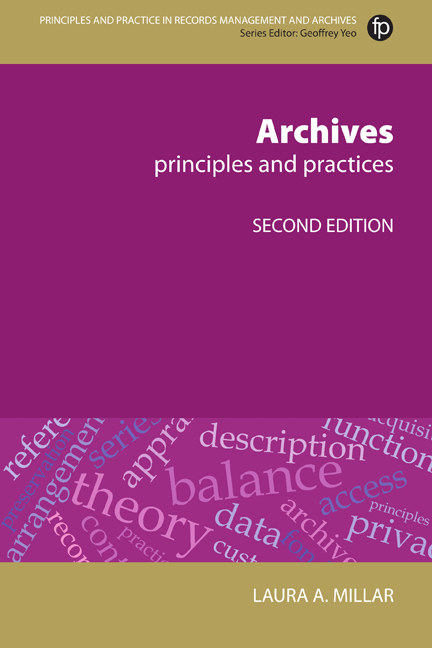Book contents
- Frontmatter
- Contents
- Figures and tables
- Foreword to the first edition
- Foreword to the second edition
- Acknowledgements
- Introduction to the second edition
- PART I ARCHIVAL PRINCIPLES
- PART II ARCHIVAL PRACTICES
- 8 Managing the institution
- 9 Preserving archives
- 10 Acquiring archives
- 11 Arranging and describing archives
- 12 Making archives available
- Conclusion
- To learn more
- Glossary of terms
- Index
- Miscellaneous Endmatter
9 - Preserving archives
from PART II - ARCHIVAL PRACTICES
Published online by Cambridge University Press: 08 June 2018
- Frontmatter
- Contents
- Figures and tables
- Foreword to the first edition
- Foreword to the second edition
- Acknowledgements
- Introduction to the second edition
- PART I ARCHIVAL PRINCIPLES
- PART II ARCHIVAL PRACTICES
- 8 Managing the institution
- 9 Preserving archives
- 10 Acquiring archives
- 11 Arranging and describing archives
- 12 Making archives available
- Conclusion
- To learn more
- Glossary of terms
- Index
- Miscellaneous Endmatter
Summary
What boots it at one gate to make defence,
And at another to let in the foe?
John Milton (1608–74) Samson Agonistes, 1671In theory, archival materials should be safer in archival custody than they were in the basement or attic of the person who created the records. Otherwise, one could argue, the archival institution should not acquire the materials in the first place. Many archivists would refute that statement, saying that if they did not bring a particular archival collection into their institution, the documents would be lost forever: shredded by a business that did not want to pay for storage or burnt by a family that had to clear out grandfather's home immediately after his death. Both positions have merit. But even if the archivist cannot achieve quality preservation controls today, she should not be ignorant of the best scenario for archival care. This chapter addresses the ideals of preservation and the realities of achieving them.
It is critical to emphasize at the start that the profession of conservation is a recognized specialty, quite distinct from archival management. Ideally, the first course of action for any archivist needing to address matters of preservation and conservation would be to work with a professional conservator or a digital preservation specialist to identify risks and establish priorities for action. In reality, though, the vast majority of archival insti - tutions do not have the resources to employ conservators or digital preservation specialists. Compromises must be made.
Fortunately, the greatest success with preservation comes not from active repairs but from basic housekeeping efforts. Keeping the facility clean, monitoring the environment, establishing temperature and relative humidity controls and reducing the risk of disasters can be much more beneficial in the long run than spending scarce resources to get cellotape off a fading map.
It is also important to remember that, whatever the ideal might be, every archival institution needs to determine its own preservation needs, in keeping with its particular social and geopolitical realities. An archival institution in northern Europe faces different preservation challenges from one in sub- Saharan Africa, and the developers of a digital repository will prioritize different preservation concerns from a special collections department with a large number of medieval manuscripts. Blanket statements about what is best in theory do not necessarily translate to achievable results in practice.
- Type
- Chapter
- Information
- ArchivesPrinciples and Practices, pp. 145 - 178Publisher: FacetPrint publication year: 2017



